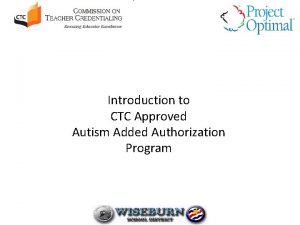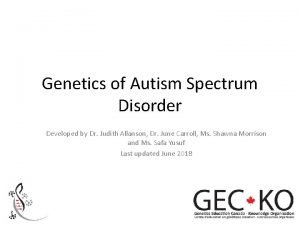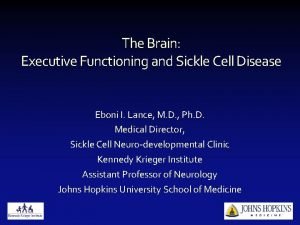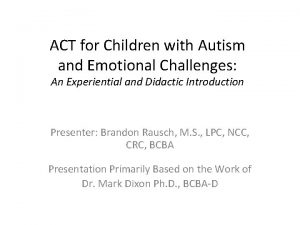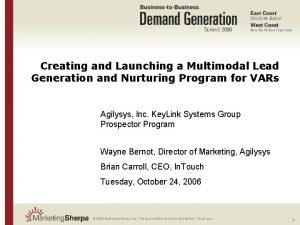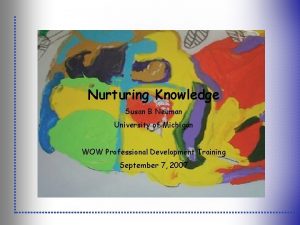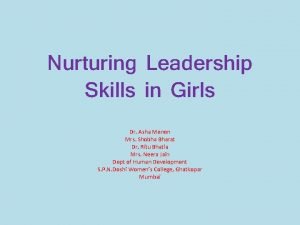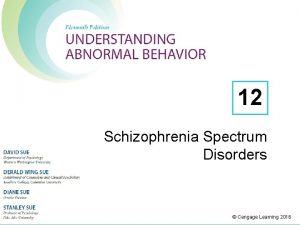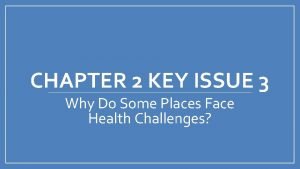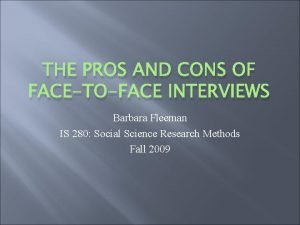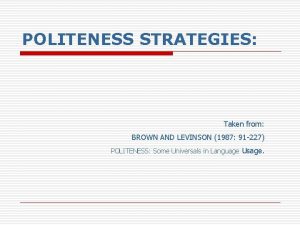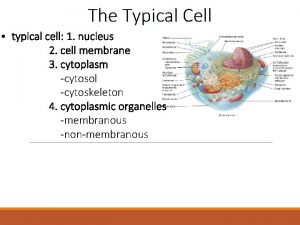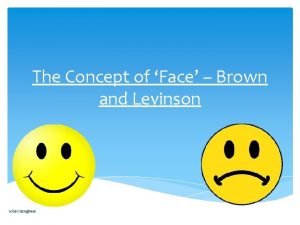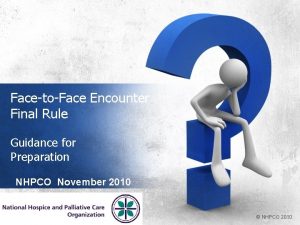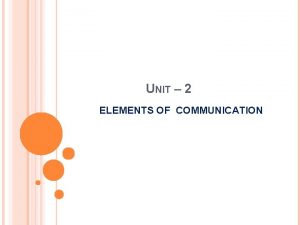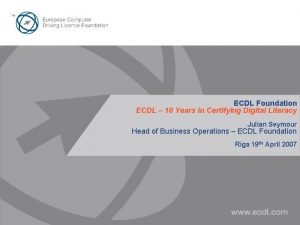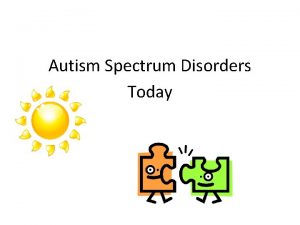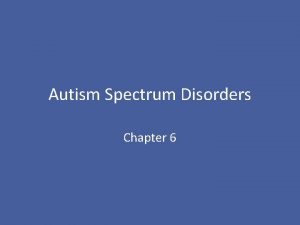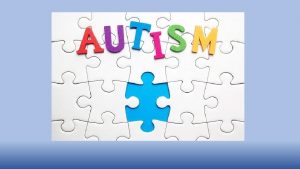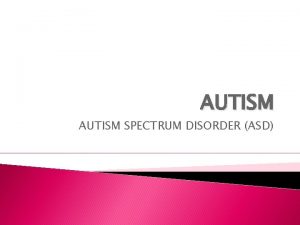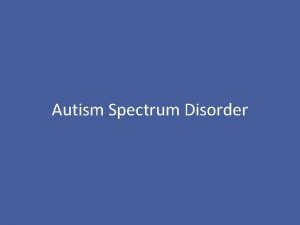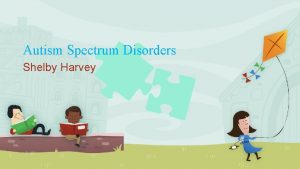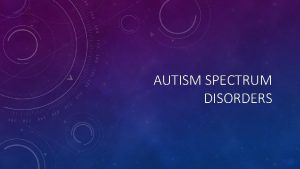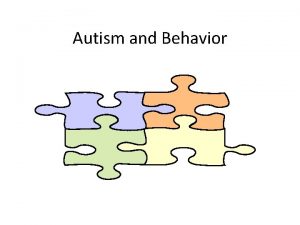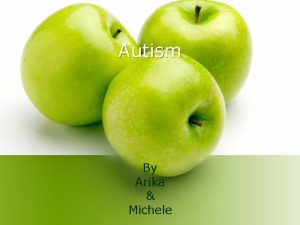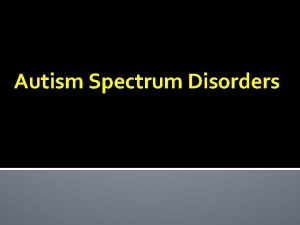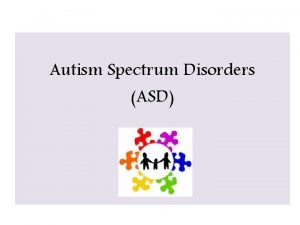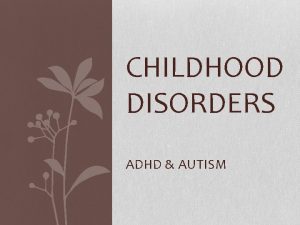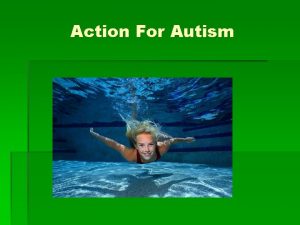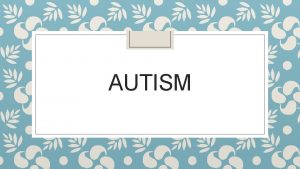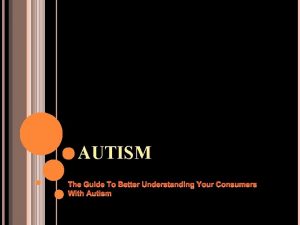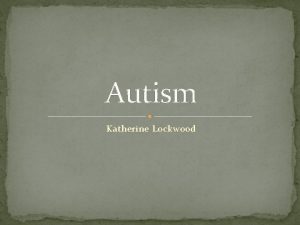The Challenges Kids Face Autism Spectrum Disorders Nurturing


























































- Slides: 58

The Challenges Kids Face: Autism Spectrum Disorders: Nurturing the “living” thing in us all Holly Lem, Ph. D. October 23, 2015

“Take a Journey with Me” http: //www. youtube. com/watch? v=0 Fyh TBv. Lu 4 w

Learning to Listen Herb Lovett “We, as a society, need to listen to people other than knowledgeable experts. We need to hear not only from academics, theoreticians, and the whole range of intelligentsia that we have attended to in the past, but also from people who are living the lives we sometimes so casually discuss!”

Asperger’s and the Public Imagination Asperger’s first appears in DSM-IV 1994 Was initially described in 1944 Most well-known of the ASDs by lay public in a very short time Disappeared by 2013 in DSM-5 Question: Will it disappear from culture as a result?

Why the Intrigue? Memoirs and films depicting people with Asperger’s (Adam; Mary and Max; Mozart and the Whale; My Autism and me) Romanticizing? Poignancy? Progress?

Relationship Manuals & Asperger’s 22 Things a Woman must know if she loves a man with Asperger’s Alone Together: Making an Asperger’s Marriage work Connecting with your Asperger’s partner Asperger Syndrome & Long Term Relationships Living with a partner or spouse who has Asperger’s

The Reason I Jump By Naoki Higashida (2007) Simply put, people with autism never feel at ease wherever we are. Because of this, we wander off or run away in search of some location where we do feel at ease. While we’re on this search, it doesn’t occur to us to consider how or where we’re going to end up. We get swallowed up by the illusion that unless we can find a place to belong, we are going to be all alone in the world.

The Heterogeneity of Autism IQ: range from impaired to gifted Communication: nonverbal to hyperlexic Social: No interest to desire w/struggles Adaptive skills: impaired to self-sufficient Behavior: repetitive self-stim to functional with special interests Motor Skills: fine & gross: tremendous variability clumsy to coordinated

Implications of Hetergeneity PDD changed to ASD Difficult to diagnose Difficult to treat in a blanket approach Difficult to isolate “a cause”

Diagnostic Dilemma: Schizophrenia? Autism Spectrum Disorder 1. 2. 3. 4. 5. 6. 7. 8. 9. 10. 11. 12. 13. 14 year-old girl Aggression (verbal/physical) Suicide attempts/ideation Self-Injurious behavior Claims to feel no pain(punched hole in wall with no feeling) Multiple hospitalizations Mood instability Flat affect, doesn’t respond to “cute things” Historically, treats friends like objects Speaks like a robot… Seeks sexual attention from boys, no other interests Uncomfortable with certain fabrics OCD like traits, rigid with schedules

Historical Figures of Note and Notoriety 1943 Leo Kanner wrote The Autistic Disturbances of Affective Contact Chronicles 11 case studies of children who present with “extreme autistic aloneness” and have an “anxiously obsessive desire for the maintenance of sameness. ” The term “autism” taken from Bleuler’s idea of childhood schizophrenia, withdrawal from reality

One step forward… One step back… “One other fact stands out prominently. In the whole group, there are very few really warmhearted fathers and mothers. … are persons strongly preoccupied with abstractions of a scientific, literary or artistic nature and limited in genuine interest in people. Even some of the happiest marriages are cold and dismal affairs. ” (Kanner, 1944)

Hans Asperger ( 1906 -1980) Austrian pediatrician Worked with 4 boys who “lacked empathy, little ability to form friendships, intense absorption in hobbies and were inflexible. ” “little professors” School for children: “autistic psychopathy” Lorna Wing (translator of Asperger in 1980/1)

Bruno Bettelheim ( 1903 -1990 Austrian Child Psychoanalyst Director of the Orthogenic School, University of Chicago Worked with “emotionally disturbed” children labeled autistic Known for his humanistic ideas about treating children- debunked later Popularized the idea of “refrigerator mother”- The Empty Fortress 1967 Committed suicide at 86 )

Bruno Bettelheim’s Impact: http: //www. youtube. com/watch? v=TQY 2 o. B 3 Rqdg

An Epidemic of Autism? CDC Report on Prevalence: 2000 1 in 150 2002 1 in 150 2004 1 in 125 2006 1 in 110 2008 1 in 88 2014 1 in 68 2016 ?

Risk Factors: ICARE project 5. 7 million kids across 5 countries (Israel, Denmark, Norway, Sweden. W. Australia) 1. Paternal Age: dads in 40’s 28% risk dads in 50’s 66% risk 2. Maternal Age: moms in 40’s 15% teen moms 18% 3. Age gap between parents: dad in 3040 s, with mom 10 years older or younger raises the risk; mom in 30 s, 10 year difference in partner, raises risk

There is no single cause for Autism… Three Strikes Hypothesis (Hornig, 2013 ) 1. Genetic predisposition: heritability- 55%-90%, 1 out of 5 siblings will have autism 2. “Environment” Paternal Age (Stefansson, 2012) Maternal deficiency in folic acid (Schmidt, 2012) Low birth weight (Lampi, 2012) Mother’s exposure to toxins (Volk, 2011; Shelton, 2012) 3. Timing: e. g, , pot smoking teens, psychosis as adults

Autism: Comparison of DSM-III (1980) with DSM-IV (1994) DSM-III: 6/6 diagnostic criteria DSM-IV: 6/12 diagnostic criteria DSM-III: a. Infantile Autism, b. Childhood onset of Pervasive Developmental Disorder DSM-IV: Pervasive Developmental Disorders Autistic Disorder Rett’s Disorder* Childhood Disintegrative Disorder Asperger’s Disorder PDD NOS

Language Differences in the DSM-III as compared to DSM-IV DSM-III: more rigid, pathologizing, less inclusive than DSM-IV A. “A pervasive lack of responsiveness to other people” (DSM-III, 1980) vs. “A lack of spontaneous seeking to share…achievements with other people” (DSM-IV, 1994)

Early Detection: Combating Autism Act (2006) http: //www. cdc. gov/ncbddd/actearly/inde x. html Learn the Signs: Act Early Program http: //www. autismspeaks. org/whatautism/diagnosis/screen-your-child M-CHAT Revised with follow-up interview (Robins, 2013)

New Findings MIND Institute, UC-Davis Enlarged infant brain- up to 7% larger than neurotypical kids Increased cerebrospinal fluid: MRIs: 6 -9 mos. (20%), 12 -15 mos (33%), 18 -24 mos. (22%) Damage in the deep regions of the brain - abnormally large neurons, poorly developed, patchy areas of cortex

Demographics (CDC, 2013) 4: 1 boys to girls; AS 9/10: 1 boys to girls Largest increase among Latino Children (110%) and African-American Children (91%) Most children are not diagnosed until they reach the age of 4 with “classic” Autism Median age for diagnosis with AS- 78 mos.

Autism Spectrum Disorder (DSM-5, 2013) Persistent deficits in social communication and social interaction across multiple contexts: 1. deficits in social-emotional reciprocity 2. deficits in nonverbal communicative behaviors 3. deficits in developing, maintaining, and understanding relationships A.

In Naoki’s words: To make myself understood, it’s like I have to speak in an unknown foreign language every minute of the day ‘Ah, don’t worry about him- he’d rather be on his own. ’ The truth is, we’d love to be with other people. But because things never, ever go right, we end up getting used to being alone without even noticing this is happening. Whenever I overhear someone remark how much I prefer being on my own, it makes me feel desperately lonely. *****

Autism Spectrum Disorder (DSM-5, 2013) B. Restricted, repetitive patterns of behavior, interests or activities as manifested by at least two of the following: 1. Stereotyped/repetitive motor movement 2. Insistence on sameness, inflexible 3. Highly restricted, fixated interests 4. Hyper or Hypoactivity to sensory input *** C. Symptoms must be present in early developmental period, may not fully manifest until social demands exceed capacities

In Naoki’s words: B 1 When I’m jumping, it’s as if my feelings are going upward to the sky. Really, my urge to be swallowed up by the sky is enough to make my heart quiver. When I’m jumping, I can feel my body parts really well too—my bounding legs and my clapping hands and that makes me feel so so good. . people with autism react physically to feelings of happiness and sadness. When I jump, I feel lighter and I think the reason my body is drawn skyward is that the motion makes me want to change into a bird and fly off to some faraway place. But constrained by ourselves and by people. . all we can do it tweet-tweet, flap our wings and hop around in a cage.

Naoki cont. B 1 Flapping our fingers and hands in front of our faces allow the light to enter our eyes in a pleasant, filtered fashion. Light that reaches us like this feels soft and gentle, like moon light. But unfiltered direct light sort of “needles” its way into the eyeballs of people with autism in sharp straight lines… this actually makes our eyes hurt.

Naoki cont. B 2 The repetition doesn’t come from our own free will. Its like our brains keep sending out the same order, time and time again. Then, while we’re repeating the action, we get to feel really good and incredibly comforted. My brain is always sending me off on little missions whether or not I want to do them. And if I don’t obey, then I have to fight a feeling of horror. Really, it’s like I’m being pushed over the brink into a kind of hell. For people with autism, living itself is a battle

DSM-5 Recording of a diagnosis of Autism Spectrum Disorder Evaluate with or without language impairment Evaluate with or without intellectual impairment Evaluate if associated with known genetic or medical condition Severity should be recorded as level of support needed in the two domains Deficits need to be pervasive and sustained

Severity Levels for Autism Spectrum Disorder Table 2 Severity levels for autism spectrum disorder Severity level Social communication Restricted, repetitive behaviors Level 3 Severe deficits in verbal and nonverbal social communication skills Inflexibility of behavior, extreme difficulty coping with change, or other “Requiring very substantial support” cause severe impairments in functioning, very limited initiation of restricted/repetitive behaviors markedly interfere with functioning in all social interactions, and minimal response to social overtures from spheres. Great distress/difficulty changing focus or action. others. For example, a person with few words of intelligible speech who rarely initiates interaction and, when he or she does, makes unusual approaches to meet needs only and responds to only very direct social approaches. Level 2 Marked deficits in verbal and nonverbal social communication skills; Inflexibility of behavior, difficulty coping with change, or other “Requiring substantial support” social impairments apparent even with supports in place; limited restricted/repetitive behaviors appear frequently enough to be obvious initiation of social interactions; and reduced or abnormal responses to to the casual observer and interfere with functioning in a variety of social overtures from others. For example, a person who speaks contexts. Distress and/or difficulty changing focus or action. simple sentences, whose interaction is limited to narrow special interests, and who has markedly odd nonverbal communication. Level 1 Without supports in place, deficits in social communication cause Inflexibility of behavior causes significant interference with functioning “Requiring support” noticeable impairments. Difficulty initiating social interactions, and in one or more contexts. Difficulty switching between activities. clear examples of atypical or unsuccessful responses to social Problems of organization and planning hamper independence. overtures of others. May appear to have decreased interest in social interactions. For example, a person who is able to speak in full sentences and engages in communication but whose to-and-fro conversation with others fails, and whose attempts to make friends are odd and typically unsuccessful.

Will the new ASD reduce diagnosis? Dr. Catherine Lord, head of DSM-5 autism group, mixed results Mattila (2011) only 46% who meet DSMIV criteria, will meet DSM-5 Taheri & Perry (2012) 63% of those meeting DSM-IV, will meet DSM-5 Mc. Partland (2012) 60% will meet DSM-5

Comparison of AS with HFA (Ortiz, 2009) Dx at “social milieu” age Social skills poor/but interested VIQ >PIQ Data Collectors Clumsy motor skills No language/cog. delay Pedantic language Psychiatric co-morbidities Asperger’s Syndrome Dx between 18 -24 mos. Poor social skills/not interested? PIQ >VIQ Object Collectors Average motor skills Language/cog. Delay Medical co-morbidities High Functioning Autism

Co-morbidities with ASD 70% have comorbid psychiatric disorder 40% have two or more comorbid dx Learning disabilities ADHD: 1/3 of kids on spectrum? Landa, 2013)*** OCD and other Anxiety Disorders Visual and Motor Impairments Sensory Processing Disorders (70 -90% may have SPD issues)

Entering the World of a Person with Autism

Some of the Challenges: The Pragmatics of Language Teacher: Will you run an errand for me? Student: (hesitatingly) sure. Teacher: I need you to bring this to the principal’s office, get it signed and bring it back to me, okay? (hands paper to student) Student: (drops paper) Teacher: Aren’t you all thumbs today? Student: (looks at thumbs) I guess so. Do you want me to come right back? Teacher: No, I want you to stop at every classroom on the way back. Student: Oh…kay.

Theory of Mind (Baron-Cohen, 2001) “A theory of mind (To. M) remains one of the quintessential abilities that makes us human. By To. M, we mean being able to infer the full range of mental states(beliefs, desires, intentions, etc. ) that cause action. In brief, having a theory of mind is to be able to reflect on the contents of one’s own and other’s minds. ”

Mindreading at 7 H: Do you think I should wear that costume? M: I thought you liked it H: But I can tell that you don’t M: Hanna, I said it was a good costume H: But I can tell you want me to wear something different, why? M: (heavy sigh)

Mindreading vs. Mindblindness Accurate “mindreading” includes being able to: 1. Read facial expressions 2. Understand tone of voice 3. Read body language 4. Be aware of unstated expectations 5. Be aware of social “hidden curriculum. ”

To. M cont. (Baron-Cohen, 2001) 1. Distinction between mental and physical states 2. Where does knowledge come from 3. Understanding one’s own intentions 4. Distinguishing between what is real and what is in someone’s mind: false belief test


Sensory Processing Issues http: //vimeo. com/52193530 Very real and very relevant May need to be addressed first (Ortiz, 2009) Hyper, Hypo, Both Can impact more than one sense modality; potentially impacts all five senses Also, relevant to kids who are not on the spectrum

What Sensory Issues might feel/look like? https: //www. autismspeaks. org/news- item/sensory-overload-film-wins-prestigious-design-award May not want to be touched or touch Wants to touch everything, sometimes hard Little to no eye contact Spins objects Over-under sensitivity to pain Reacts strongly to smells, lights, noises Overly active, under responsive

Naoki on Sensory Issues: There are certain noises you don’t notice but that really get to us. The problem here is that you don’t understand how these noises affect us. It’s not quite that the noises grate on our nerves. It’s more to do with a fear that if we keep listening, we’ll lose all sense of where we are. At times like these, it feels as if the ground is shaking and the landscape around us starts coming to get us and its absolutely terrifying. So cupping our ears is a measure we take to protect ourselves and get back our grip on where we are… what matters most is that we learn to feel safe and secure even when the noises strike us.

Environmental Friendly Space Visually calm Quiet Moderate temperature Clearly defined work space Not overly crowded with stuff/people Well-organized Predictable

Interventions for Sensory Issues Deep pressure Slow swinging Brushing the skin (Wilbarger’s Method) Chewing Activities Ball play See Carol Kranowitz, The Out-of-Sync Child

The Cycle of Tantrums, Rage and Meltdown (Myles & Southwick, 1999) Promote self-awareness, self-calming, self -management 1. The Rumbling Stage Behaviors? (biting nails/lips, grimacing, tap feet) Triggers? Interventions? 2. The Rage Stage Safety Dignity 3. The Recovery Stage

Interventions/Pre-emptive Strategies (Myles and Southwick, 1999) 1. Antiseptic Bouncing Signal Interference- “secret signal” 3. Proximity Control 4. Walk Don’t Talk 5. Home Base 2.

In Naoki’s words: When I see I’ve made a mistake, my mind shuts down. I cry, I scream, I make a huge fuss and I just can’t think straight anymore…I know really that it’s not such a big deal. But it’s almost impossible for me to keep my emotions contained. I get swallowed up in the moment… All I know is that I have to get out of the situation as soon as I can, so I don’t drown. To get away, I’ll do anything… Then I see no sign of the tsunami attack-only the wreckage I’ve made. And when I see that, I hate myself. I just hate myself.

Behavior is always a form of communication: What does it mean? Comic Strip Conversations (Carol Gray) www. thegraycenter. org Social Stories (Carol Gray) www. thegraycenter. org Power Cards (Elisa Gagnon)

Learning to Listen (Lovett, 2005) “Many times troubling behavior alerts us to a pressing need, but our response focuses on making the behavior go away rather than on satisfying the person’s intentions or desires. ”

What to keep in mind: (Ortiz, 2009) 1. Strengths 2. Self-Esteem 3. Stress Management 4. Structure 5. Sensitivities

In Naoki’s words: Every single time I’m talked down to, I end up feeling utterly miserable as if I’m being given zero chance of a decent future

Early Start Denver Model (ESDM) Rogers and Dawson 1. 2. 3. 4. 5. 6. Use naturalistic applied behavior analysis (ABA) Deep parental involvement Focus on interpersonal exchange/positive affect Shared engagement with joint activities For ages 12 to 48 mos. 15 hours a week by therapists, 5 hours by parents

Case Presentation “Janet”- 13 y. o girl Straight “A” student Middle class family: stay-at-home mom, dad worked with computers Seen at Yale Child Study Center for “behavioral issues” Attacked mom with a butcher knife Psychosis?

Male-Female Differences with AS (Ortiz, 2010) Girls: More internalized presentation (anxiety, depression) 2. Co-morbid learning challenges 3. Stronger social pragmatics 4. Prefers practical appearance over fashionable 5. Viewed as passive, shy, “immature for age”, not disruptive 6. “Double-whammied” by societal expectations 1.

Resource for Families to gain and share information http: //www. iancommunity. org/cs/about_i an

Taking Home Naoki’s Wisdom Every single time I’m talked down to, I end up feeling utterly miserable as if I’m being given zero chance of a decent future
 Autism authorization california online
Autism authorization california online Puberty and autism spectrum disorders
Puberty and autism spectrum disorders Autism spectrum disorder
Autism spectrum disorder Autism spectrum disorder adhd
Autism spectrum disorder adhd Asd levels
Asd levels Types of autism
Types of autism Self as context
Self as context Charter school marketing
Charter school marketing Supplementary nurturing
Supplementary nurturing Hot prospector reseller
Hot prospector reseller Nurturing knowledge
Nurturing knowledge Yvonne monaghan
Yvonne monaghan Dr asha menon
Dr asha menon Nurturing school
Nurturing school Kids r kids west cobb
Kids r kids west cobb Is schizophrenia on a spectrum
Is schizophrenia on a spectrum Chapter 12 schizophrenia spectrum disorders
Chapter 12 schizophrenia spectrum disorders Chapter
Chapter Absortpion
Absortpion Henry hudson face
Henry hudson face Key issue 3 why do some places face health challenges
Key issue 3 why do some places face health challenges What challenges did calvin coolidge face
What challenges did calvin coolidge face War at home vs war abroad madison
War at home vs war abroad madison Politeness and interaction
Politeness and interaction Example of alliteration in romeo and juliet act 1
Example of alliteration in romeo and juliet act 1 Face to face interview pros and cons
Face to face interview pros and cons Bald on record
Bald on record Cis face and trans face
Cis face and trans face Negative face
Negative face Face-to-face narrative examples
Face-to-face narrative examples Myron b thompson academy
Myron b thompson academy I have a flat face
I have a flat face Elements of communication
Elements of communication Ecdl foundation
Ecdl foundation Diễn thế sinh thái là
Diễn thế sinh thái là Vẽ hình chiếu vuông góc của vật thể sau
Vẽ hình chiếu vuông góc của vật thể sau Công của trọng lực
Công của trọng lực Làm thế nào để 102-1=99
Làm thế nào để 102-1=99 Tỉ lệ cơ thể trẻ em
Tỉ lệ cơ thể trẻ em Lời thề hippocrates
Lời thề hippocrates đại từ thay thế
đại từ thay thế Vẽ hình chiếu đứng bằng cạnh của vật thể
Vẽ hình chiếu đứng bằng cạnh của vật thể Quá trình desamine hóa có thể tạo ra
Quá trình desamine hóa có thể tạo ra Môn thể thao bắt đầu bằng chữ đua
Môn thể thao bắt đầu bằng chữ đua Thế nào là mạng điện lắp đặt kiểu nổi
Thế nào là mạng điện lắp đặt kiểu nổi Hát kết hợp bộ gõ cơ thể
Hát kết hợp bộ gõ cơ thể Khi nào hổ con có thể sống độc lập
Khi nào hổ con có thể sống độc lập Dạng đột biến một nhiễm là
Dạng đột biến một nhiễm là Nguyên nhân của sự mỏi cơ sinh 8
Nguyên nhân của sự mỏi cơ sinh 8 độ dài liên kết
độ dài liên kết Chó sói
Chó sói Thiếu nhi thế giới liên hoan
Thiếu nhi thế giới liên hoan Fecboak
Fecboak điện thế nghỉ
điện thế nghỉ Một số thể thơ truyền thống
Một số thể thơ truyền thống Trời xanh đây là của chúng ta thể thơ
Trời xanh đây là của chúng ta thể thơ Thế nào là hệ số cao nhất
Thế nào là hệ số cao nhất Sơ đồ cơ thể người
Sơ đồ cơ thể người Frameset trong html5
Frameset trong html5
